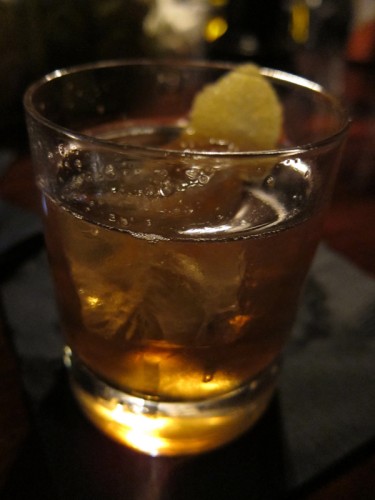Yes, I still live and breathe. I’ve been talking to Stella about how to get my groove back, and she’s got a handle on it.
This is a linky-goodness post, as there have been some fascinating articles of late on the subject of mixing cocktails — to wit, on sweetness, balance, dilution and temperature.
First off, Chicago bartender Todd Appel puts forward a good case for why we should stop using 1:1 simple syrup.
I never have been a fan of 1:1 simple; it’s always seemed watery and not sweet enough, and simple math makes one wonder how a teaspoon of granulated or “powdered” sugar, called for in so many classic recipes, can be justifiably substituted with a teaspoon of something that’s got so much water in it. I’m not a fan of overly sweet cocktails either, but you have to have balance — sweet with the sour or bitter or strong, and plain ol’ sugar water doesn’t cut it. Todd starts off his article with the same observations:
For years I have wondered why my taste buds seemed to be at odds with many of the classic and new cocktails being offered around the country in our modern cocktail world.
I realized something important many years ago
Syrup in cocktails should be sugar heavy, period.
The problem here is twofold. 1-1 syrup offers more water and less sugar. This leads to more dilution and/or overly acidic drinks.
This is a recognized issue, hence the discussion of what many call “rich” simple syrup, made 2:1 with double the amount of sugar as water. This helps a great deal, but is it enough?
He reminds us of David Embury as well — we may have thought some of his ratios a bit wonky, but it’s easy to gloss over the ratio of syrup to water in the simple syrup he made, which was basically liquid sugar. Embury, plus at least one book by William Terrington from 1870, call for a 3:1 syrup!
I’m at the point now where I only use 2:1 simple syrup, for the simple reason that 1:1 simple syrup is by no means a substitute for the same volume of granulated sugar. I’m going to try a small batch of the more concentrated syrup and see where that gets me … mmm, cocktail experimentation.
Moving on!
It killed me to have to miss the 2010 edition Tales of the Cocktail, especially because the quality of the seminars truly shone this year. One of the more talked-about sessions (and one of the ones I was most annoyed to have missed) was The Science of Stirring, taught by Dave Arnold (Director of Culinary Technology at the French Culinary Institute in New York), bartender/beverage director Eben Klemm and Death & Co. bartender Thomas Waugh.
Dave has written another pair of epic posts about the seminar and the cocktail-making science explored within. Part 1 deals with shaking, stirring, temperature and dilution, and Part 2 with temperature and dilution, texture, notes on batching drinks and an epilogue from Waugh about how all this science stuff affects a real live bartender. Here’s the brief introduction:
Cocktail shaking is a violent activity. If you shake for around 12-15 seconds (though shaking longer won’t hurt), and if you aren’t too lethargic, neither the type of ice you use nor your shaking style will appreciably affect the temperature or dilution of your drink. Shaking completely chills, dilutes and aerates a drink in around 15 seconds, after which the drink stops changing radically and reaches relative equilibrium. Shaking is basically insensitive to bartender-induced variables. See my post on The Science of Shaking. [Definitely read this if you haven’t already. — CT]
Stirring is different. Think of stirring as inefficient shaking. It can take over 2 minutes of constant stirring to do what shaking can accomplish in 15 seconds. No one stirs a drink for 2 minutes, so the drink never reaches an equilibrium point. All the bartender-induced variables – size of ice, speed of stirring, duration of stirring, etc. — make a difference in stirred cocktails, so bartender skill is very important in a stirred cocktail.
Because stirring doesn’t reach equilibrium, stirred drinks are warmer and less diluted than shaken cocktails. Stirred drinks, unlike shaken ones, are not aerated. Stirring does not alter the texture of a drink –it merely chills and dilutes. A properly diluted cocktail stored at -5 degrees Celsius in a freezer is indistinguishable from a properly stirred one.
There’s a lot of reading here, and it does get quite scientific (for those of you who might be scared away by such things, don’t — it’s really fascinating and worth the effort). If the science is too much you can always skip down to Waugh’s final list of things for the everyday bartender to remember, the first of which you can begin implementing right away (if you haven’t already copied it from seeing better bartenders do it when you go out):
1. Chill your mixing (stirring) glass — ice works, as does a fridge or freezer.
This is all fascinating stuff, and a must-read for everyone interested in executing a properly stirred cocktail.
. (Pre-order at this link or, preferably, pick it up on its publication date of November 2 at your nearest independent bookseller.) You can now also






